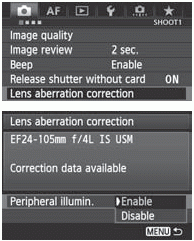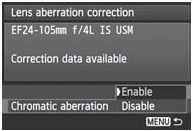Lens Peripheral Illumination / Chromatic Aberration Correction
Peripheral light fall-off occurs in lenses whose characteristics make the image corners look darker. Color fringing along subject outlines also is a chromatic aberration. Light fall-off and color fringing can be corrected.
The default setting is [Enable] for corrections
Peripheral Illumination Correction
 | 1 Select [Lens aberration correction]. 2 Select the setting. Check that [Correction data available] is displayed for the attached lens. Turn the < > dial to select [Peripheral illumin.], then press < > dial to select [Peripheral illumin.], then press < >. >. Select [Enable], then press < >. >. If [Correction data not available] is displayed, see “About the Lens Correction Data”
3 Take the picture. |
About the Lens Correction Data
The camera already contains lens peripheral illumination correction data and chromatic aberration correction data for approx. 25 lenses. If you select [Enable], the peripheral illumination correction and chromatic aberration correction will be applied automatically for any lens whose correction data has been registered in the camera.
With EOS Utility (provided software), you can check which lenses have their correction data registered in the camera. You can also register the correction data for unregistered lenses. For details, refer to the Software Instruction Manual (CD-ROM) for EOS Utility
Depending on shooting conditions, noise may appear on the image periphery.
Chromatic Aberration Correction
 | 1 Select the setting. Check that [Correction data available] is displayed for the attached lens. Turn the < > dial to select [Chromatic aberration], then press < > dial to select [Chromatic aberration], then press < >. >. Select [Enable], then press < >. >. If [Correction data not available] is displayed, see “About the Lens Correction Data” on the next page.
2 Take the picture. |
If you play back a RAW image shot with the chromatic aberration corrected, the image will be displayed on the camera without the chromatic aberration correction applied. Check the chromatic aberration correction with Digital Photo Professional
Notes for peripheral illumination correction and chromatic aberration correction
About the Lens Correction Data
Corrections cannot be applied to JPEG images captured when [Disable] was set.
When using a non-Canon lens, setting the corrections to [Disable] is recommended, even if [Correction data available] is displayed.
If you use the magnified view during Live View shooting, the peripheral illumination correction and chromatic aberration correction will not be reflected in the image.
If the effect of the correction is not so visible magnify the image and check it.
The corrections are also applied when an Extender is attached.
If the correction data for the attached lens is not registered to the camera, the result will be the same as when the correction is set to [Disable].
If the lens does not have distance information, the correction amount will be lower.